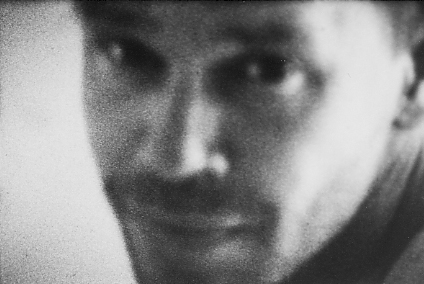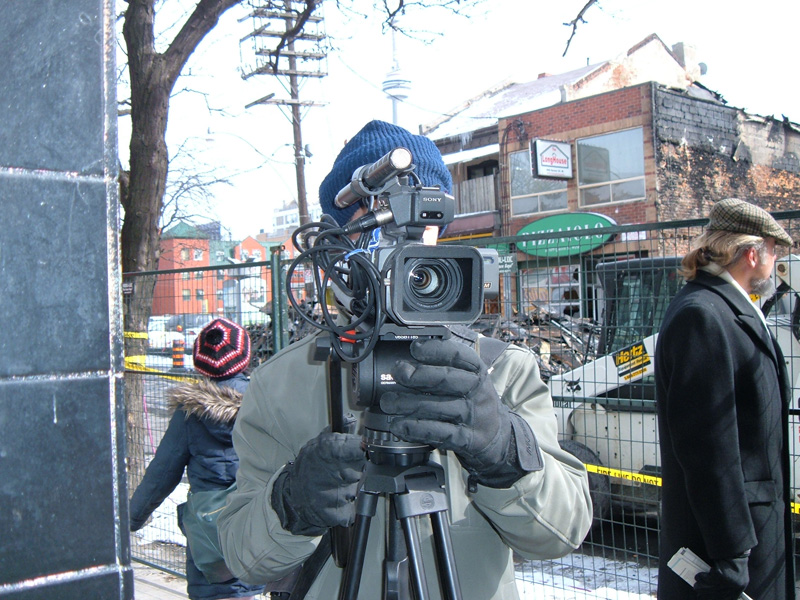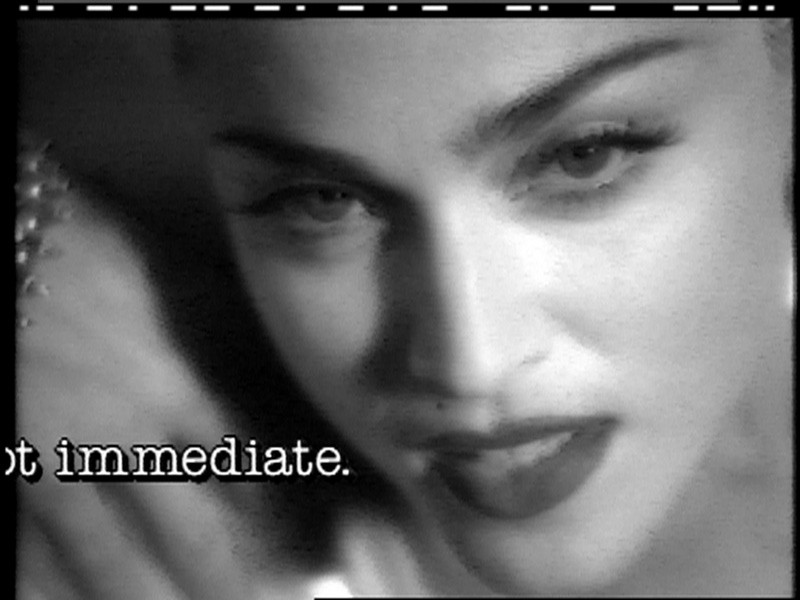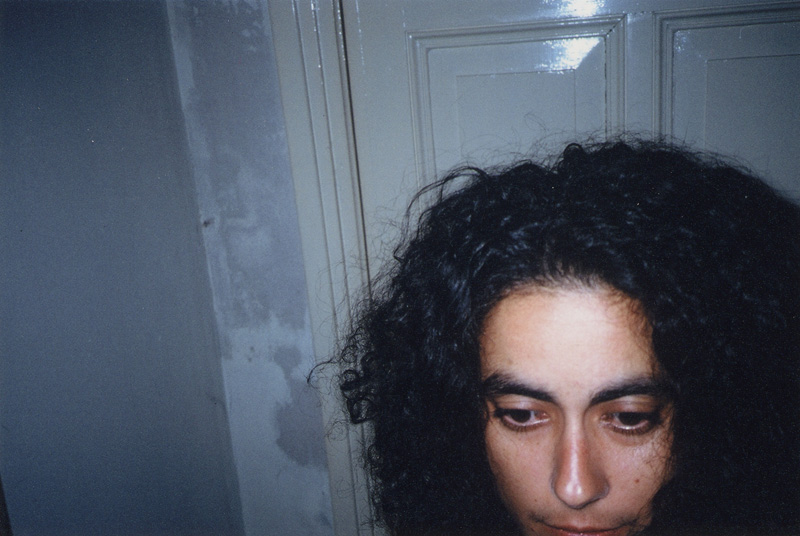Part of Winter 2010
Pleasure Dome is pleased to present the Toronto premiere of Public Lighting (76 min., 2004). “Mike Hoolboom returns with a captivating, richly layered experimental feature exploring the “cult of personality” and the role photographs play in creating memory. A young author introduces the premise that there are six types of personality. Six stories demonstrate the thesis, ranging from a gay man recounting the locations of various breakups to an homage to composer Philip Glass and a confessional letter from an HIV-positive man to Madonna.” (Outfest Festival)
Winner for Best Experimental, Santa Cruz Festival, 2004; Best Director, Pyongyang Festival, Korea, 2004; and Best Documentary, Festival du Nouveau Cinema, Montreal, 2004.
At 7pm please join us for the re-launch of Projecting Questions? (Mike Hoolboom’s Invisible Man between the art gallery and the movie theatre, an Art Gallery of York University exhibition monograph, handsomely designed by Lisa Kiss. A series of essays and conversations between artists and curators on the complicated path from the white cube to the black box. Featuring contributions by Philip Monk, Chris Kennedy, Yann Beauvais and Mike Hoolboom.
“Public Lighting is a meditation on photography and the creation of images that can capture, replace and outlive our experiences. It’s a video film in seven parts, related in both subject and sentiment to the wonderful Imitations of Life. Each chapter is a case study of the different types of personality that have been identified by the young author who guides us through the prologue. The first, a gay man, takes us on a tour of the bars and restaurants where his affairs have ended, recounting ironic stories of his many lovers. An homage to Philip Glass is incongruously followed by Hey Madonna, a confessional letter to the singer from a fan who is HIV positive. Carolynne celebrates another birthday, but has lost her memory to television. At least she has a camera. Hiro lives life at a distance, rarely venturing out beyond the lens, and an anxious young model recounts poignant moments from her past. Few filmmakers use re-appropriated footage in such an emotive way: at once humorous and incisive, these chains of images inevitably lead us back to parts of ourselves. Hoolboom’s recent work is in profound sympathy with the human condition that speaks directly to our hearts.” (Mark Webber, London Film Festival)
Programme Notes:
How do we tell the story of a life? What cruel reduction of an image will stand (in the obituary, the family photo album, the memory of friends) for the years between a grave and a difficult birth? Public Lighting (video, 76 min., 2004) examines the current media obsession with biography, offering up “the six different kinds of personality” (the obsessive, the narcissist…) as case studies and miniatures, possible examples.
“Prolific Canadian experimental filmmaker Mike Hoolboom’s Public Lighting surpasses even the beauty of his most recent work, Imitations of Life. Visually dense and hypnotic while brimming with the kind of penetrating ideas one associates with Godard, Public Lighting ponders the ways in which seeing and hearing affect human consciousness. While avant-garde fans will file it as essential viewing, the loveliness of this concise rumination should draw a wider audience in its current fest tour and through video distribution.
Divided into seven chapters, pic opens on a light spectrum as a symbol for pic’s range of views, launched by an introductory chapter with Hoolboom’s alter-ego, a female author (voiced by Esma Mouhktar) explaining that in the following six chapters, she will tell of six kinds of sadness fitting six personality types all under the umbrella title of Public Lighting.
In the City recalls early Peter Greenaway in its ironic storytelling wherein a male voice (Ken Thompson) describes his breakups with each of his boyfriends, paired to a gorgeous montage of restaurants and city scenes. The Greenaway touch spills over slightly to Glass, in which Hoolboom honors composer Philip Glass with a fantastically limpid tone poem of images and selected fragments from some of Glass’ better-known pieces, capped with a suitably spare scene of Glass alone at his piano.
Hoolboom has long taken found footage and made it his own, and he amusingly does this with Hey Madonna, which includes bits from Truth or Dare (including Warren Beatty grilling the diva on why she allows herself to be filmed at all times) and videos like Vogue. What turns the images upside down is how they’re presented in the context of an apparently fictitious letter written by a gay man dying from AIDS, who claims to have slept with Madonna, and ponders sadly how the superstar is starting to show her age.
Next two chapters (Tradition, Hiro) are about image-makers with roots in Asia — one, a North American lenser of Chinese parentage who’s cajoled to return to the home country and ponders if her life isn’t unfolding in some sort of strange loop; the other is a brilliantly edited, highly impressionistic segment on Japanese photographer Hiro Kanagawa as he looks for nighttime subjects and stumbles across a corpse.
Finale, Amy, is narrated by a model (Liisa Repo-Martell) who’s painfully uncomfortable with her own body and “old woman’s” face. Astonishing closing image is a tightly composed telephoto shot on the start of a marathon race among young schoolgirls, dashing toward and then across the screen in ultra-slow-motion, and accompanied by a girls’ chorus hauntingly singing Brian Wilson’s God Only Knows. Widely eclectic lensing and looks in various media and in color and black-and-white flow nicely from one section to the next, aided by gifted editor Mark Karbusicky.” (Robert Koehler, Variety)
“Mike Hoolboom puts together some disparate clips, some beautiful images and hesitant shots from family, fiction, reality archive and advertising films (the Japanese advertisement for an all-purpose cleaning fabric is hilarious). Some images have been found or borrowed while others are original and have been shot for the purposes of the film. In the images there are also words, uttered in short sentences, and the voices of men and women. But this is only half the story. The filmmaker uses a dual approach to images and sounds to construct his unique universe. On the one hand, he gives them depth by slowdown effects, fade-ins and fade-outs, solarization, intermingling of visuals and sound in a complex dramatization relationship. Public Lighting thus consists of strong images that show us the ages of history, its moments of grandeur and shame, touching on the public and private spheres, mingling show-biz and intimacy. An image in a Hoolboom film is always multiple, a confusing palimpsest that is embedded at a certain point in a different image, a pagan icon that keeps trace of the movement of a body, the expression of a face, the inflection of a voice. On the other hand, although this magnificently impure film is based on a very elaborate editing rhetoric, its profound movement leads to uninterrupted mediation.
Public Lighting consists of six portraits which a young writer announces at the beginning of the film. These six people tell of ordinary follies, narcissistic obsessions, demiurgic desires and wounded memories. The separated man, the obstinate pianist, the aging singer, the Chinese émigré, the nocturnal Japanese and the confessed woman are fragments of a collective history. The warm lighting used by Mike Hoolboom illuminates sleepless nights when one is no longer prepared to be deceived—at least for a while-by the ghostly apparitions that haunt our dreams. A single image then appears to emerge. That of a poetic intelligence worried about the world, in which the grave and lucid Hoolboomian hero aspires to some recognition, to a semblance of eternity and to a ‘genuine’ place in the movement of life.” (Jean Perret, Visions du Réel Catalogue)
Three Notes on Public Lighting by Andrea Slovakova
1. “When I write, I see the shapes behind things,” says the writer from Public Lighting. We need shapes as the interface between words and not-words, between the seen and unseen. Some immanent structure is required, like the melody links in Philip Glass’s minimalism, which arise not only from repetitions of a unique loop, but out of imaginary, polysemic interconnections and divergences between loops. The onscreen text replies, “It is not the melody people listen to, but its endurance.” I would add: the behaviour of enduring. What is important is not the fact of its endurance, but how.
2. “I take pictures to record my forgetting,” says the filmmaker portrayed in Public Lighting. The camera observes a woman in celebration, poised above her cake which shines with light. We hear only the crackling of firecrackers, her laughter is withheld from us, though her mirth still looks convincing. Except it’s not because she can’t remember it. The image dissolves, because we must not perceive its memory as a testimony; only as shards of isolated gestures being materialized now in different times (the times of those who watch).
3. The last shot of Public Lighting shows a crowd of running children, and while the entire screen is in motion there is an unbearable feeling of constraint, and the memory of meaningless long-distance runs, the body stretched across useless achievements. Finally, when they have all come and gone, and run their race, one girl is left behind, askew, the closer she gets, the more pained and laboured she appears. Every race holds a place for the one who arrives first and another for the last one.
The nervous feeling in the shot coalesces inside her.
We do not hear a single sound. This memory carries its sensations in the muscles and stomach contractions, her eyesight fixed on the backs of the faster ones. Ears have not remembered this situation. Vital spontaneity and a systematic method mixed-up in a logic of inner rhythms of the mini-stories emerge across Public Lighting’s seven parts, not as narratives but as an a-dramatic flux.
Public Lighting Credits:
Director, Producer, Writer, Camera: Mike Hoolboom
Editor: Mark Karbusicky
Editors: Aleesa Cohene, Dennis Day, Robert Kennedy, Elizabeth Schroder,
Ross Turnbull
Additional Footage: Herbert Hanson, Carolynne Hew, Fred Pelon
Featuring: Esma Moukhtar, Ken Thompson, Steve Reinke, Hiro Kanagawa, Liisa Repo-Martell, Carolynne Hew
Thanks to Shawn Chappelle and Heather Frise. Thanks to Charles Street Video and the Western Front
This video was made possible by the kindness of the Making Scenes Festival and Canada Council
Mike Hoolboom is a Canadian artist working in film and video. He has made over fifty films and videos, though most have been withdrawn from circulation, approximately a dozen remain on view. His work has appeared in over four hundred festivals, garnering thirty awards. He has been granted the Tom Berner Award for community service and two lifetime achievement awards, the first from the city of Toronto, and the second from the Mediawave Festival in Hungary.
He has enjoyed retrospectives of his work at the Images Festival (Toronto), Visions du Reel (Switzerland), Cork International Festival (Ireland), Cinema de Balie (Amsterdam), Mediawave Festival (Hungary), Impakt Festival (Holland), Vila do Conde Festival (Portugal), Jihlava Documentary Festival (Czech Republic), Stuttgarter Filmwinter (Germany), Musée des Beaux-Arts de Caen (France), Sixpack Film (Vienna), the Buenos Aires International Festival (Argentina), and A Million Different Loves Festival in Poland.
He is a founding member of the Pleasure Dome screening collective and has worked as the artistic director of the Images Festival and as the experimental film co-ordinator at Canadian Filmmakers Distribution Centre.
Mike Hoolboom has published a pair of interview books with Canadian media artists, Practical Dreamers: Conversations with Media Artists (Coach House Press, 2008) and Inside the Pleasure Dome: Fringe Film in Canada (Coach House Press, 2001). He has edited or co-edited books on Frank Cole, Barbara Sternberg and Philip Hoffman, in addition to publishing electronic books on Deirdre Logue, Dani Leventhal, Al Razutis, Mike Cartmell, Steve Reinke, American fringe movies and the documentary. In 1998 he authored Plague Years (YYZ Books) a tongue-in-chic autobiography. His first novel The Steve Machine was published by Coach House Press in the fall of 2008. He has published more than one hundred articles on fringe media which have appeared in magazines and catalogues around the world.
Since 2004 he has been working on Fringe Online www.fringeonline.ca, a web project which makes available the archives of a number of Canadian media artists. This ongoing project currently consists of hundreds of pages of transcripts, reviews, interviews and scripts, and remains the largest publishing project in the Canadian fringe media sector.
Esma Moukhtar on Public Lighting: “Memory is also a function of personality, and its staging shifts according to personal inclination. But the personal is bound and mediated by the images which surround us. Sometimes images can take away the sight of one’s own face, or a whole life’s story can be reduced to a single frame. In Public Lighting six different life stories are on offer as personality types. As in Panic Bodies and Imitations of Life, Hoolboom works in separate chapters. In the case of Public Lighting there is an introduction, Writing, in which a writing narrator formulates with hesitation thoughts six different kinds of ‘personality’ that follow in the next stories and contemplations. Each story demonstrates a different mode of public display (of staging interiority) and uses different formal strategies to enact them. In the City utilizes layers of superimposition while a man we don’t see narrates a series of break ups in 26 alphabetically arranged restaurants. Glass is a portrait of the composer Philip Glass, using archival footage of New York. Hey Madonna shows a fan letter scrolled over her video clips. Tradition tells a generational tale of forgetting and repetition, set on two continents. Hiro is a wordless psychodrama about a photographer haunted by atomic memories. The closing chapter, Amy, portrays a woman recounting her childhood in which she has been photographed by the same man over and over—she can only look at herself the way he looked at her then, and the way we are looking at her now. Once again Hoolboom combines his own film material with found footage, clips and icons, interweaving texts and voice-overs. These portraits (which are sometimes city portraits as well) and meditations each represent a way of being, of recounting and of telling. Each perspective is also a retrospective. The past is derived from a domain of pictures, which on the one hand don’t belong to the subject, but on the other hand provide their roots of memory and subjectivity. They are spoken by language. Their personalities are apertures for external pictures and sound.” (Esma Moukhtar, Montevideo Catalogue)




